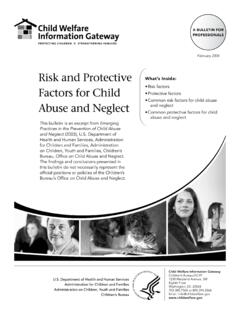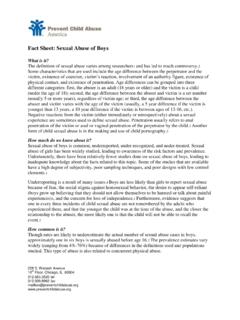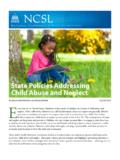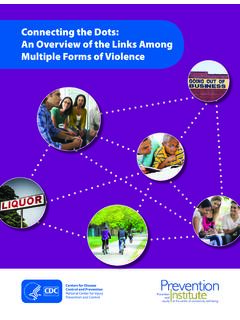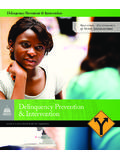Transcription of Protective Factors Approaches in Child Welfare
1 Children s Bureau/ACYF/ | Email: | BRIEFF ebruary 2014 Protective Factors Approaches in Child WelfareWHAT S INSIDEWhat are risk and Protective Factors ?Why is a Protective Factors approach important?Using Protective Factors in Child maltreatmentMapping connections across Protective Factors approachesIndividual Protective factorsRelational Protective factorsSocietal or community Protective factorsPutting Protective Factors into practiceConclusionResourcesThis issue brief provides a succinct overview of Protective Factors Approaches to the prevention and treatment of Child abuse and neglect .
2 It is designed to help policymakers, administrators, Child Welfare and related professionals, service providers, advocates, and other interested individuals understand the concepts of risk and Protective Factors in families and communities and learn ways in which building Protective Factors can help to lessen risks for Child abuse and Are Risk and Protective Factors ?Risk Factors refer to the stressful conditions, events, or circumstances ( , maternal depression, substance abuse , family violence, persistent poverty) that increase a family s chances for poor outcomes, including Child abuse and neglect .
3 Protective Factors are conditions or attributes of individuals, families, communities, or the larger society that mitigate risk and promote healthy development and well-being. Put simply, they are the strengths that help to buffer and support families at risk. :/sw.:cil/sptdcefftpl/a:dcwrcgawovc :o lt:2 This material may be freely reproduced and distributed. However, when doing so, please credit Child Welfare Information Gateway. Available online at Is a Protective Factors Approach Important? Traditionally, Child maltreatment prevention and intervention strategies have focused exclusively on risk Factors and their elimination.
4 We now know that changing the balance between risk and Protective Factors so that Protective Factors outweigh risk Factors is a more effective prevention and intervention strategy. Helping children and families build resilience and develop skills, characteristics, knowledge, and relationships that offset risk exposure can contribute to both short- and long-term positive outcomes. Using a Protective Factors approach can be a positive way to engage families because it focuses on families strengths and what they are doing right. Focusing exclusively on risk Factors with families can leave families feeling stigmatized or unfairly judged.
5 Also, a Protective Factors approach can provide a strong platform for building collaborative partnerships with other service providers like Child care that are not as familiar or comfortable with a risk paradigm as a basis for engaging families. Using Protective Factors in Child MaltreatmentThe emphasis on Protective Factors continues to grow, and today they are used by practitioners, policymakers, and researchers to improve Child , family, and community well-being. Currently, there are several key Protective Factors Approaches in use, including the following: Strengthening Families and Youth Thrive were developed by the Center for the Study of Social Policy (CSSP).
6 Essentials for Childhood is an approach developed by the Centers for Disease Control and Prevention (CDC). The Administration on Children, Youth and Families (ACYF), Administration for Children and Families, Department of Health and Human Services (HHS) is currently working on an approach that identifies Protective Factors specifically relevant across the populations served by ACYF. This brief aligns and interconnects the information across these Protective Factors Approaches . Strengthening FamiliesStrengthening Families is focused on building five Protective Factors that are associated in the research literature with lower rates of Child abuse and neglect and with optimal Child development: Parental Resilience Social Connections Knowledge of Parenting and Child Development Concrete Support in Times of Need Social-Emotional Competence of Children Strengthening Families is the most well-established and broadly used Protective Factors approach in the field of Child abuse and neglect prevention.
7 In addition to the research literature, the development of the Strengthening Families approach was supported by:1 A national study of exemplary practice A 2-year, seven-State pilot study Structured learning from a national network of implementers Learning from four research studies being conducted under the ACYF-funded National Quality Improvement Center on Early ChildhoodMore than 40 States have initiated statewide Strengthening Families efforts, and a majority of all States are using Strengthening Families for Child abuse and neglect prevention programming. It is also being used in multiple other sectors, including early childhood, Child Welfare services, family support, and home visiting, to name a few.
8 Because of its longstanding application in the field, Strengthening Families is also supported by a wide range of implementation tools and materials, as well as active learning communities of implementers. More information on Strengthening Families can be found at 1 More information on this work can be found at the following link: u201arbe42htteb1apu42ys2: material may be freely reproduced and distributed. However, when doing so, please credit Child Welfare Information Gateway. Available online at ThriveThe Youth Thrive Protective Factors approach focuses on adolescents, with a particular focus on youth receiving Child Welfare services.
9 This approach describes how youth can be supported by parents and practitioners in ways that advance healthy development and well-being and reduce the impact of negative life experiences. There are five Protective Factors in the Youth Thrive framework: Youth Resilience Social Connections Knowledge of Adolescent Development Concrete Support in Times of Need Cognitive and Social-Emotional CompetenceA national study of exemplary practice is underway to learn from programs that are building the Youth Thrive Protective Factors into their practice with youth facing challenging circumstances.
10 New Jersey is piloting the application of Youth Thrive to the youth services provided for youth involved with Child Welfare . More Youth Thrive implementation tools will be available to the field in coming for ChildhoodThe CDC s National Center for Injury Prevention and Control has defined three critical qualities of relationships and environments that can reduce the occurrence and negative effects of Child maltreatment and other adverse childhood experiences: Safety: The extent to which a Child is free from fear and secure from physical or psychological harm within his or her social and physical environment Stability.










